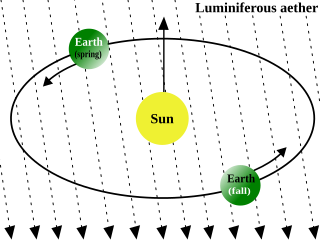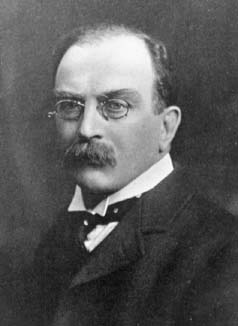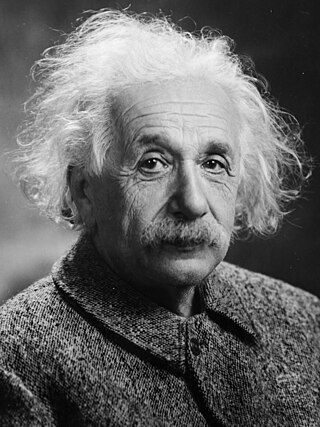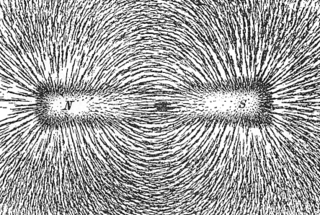
Luminiferous aether or ether was the postulated medium for the propagation of light. It was invoked to explain the ability of the apparently wave-based light to propagate through empty space, something that waves should not be able to do. The assumption of a spatial plenum of luminiferous aether, rather than a spatial vacuum, provided the theoretical medium that was required by wave theories of light.

The theory of relativity usually encompasses two interrelated physics theories by Albert Einstein: special relativity and general relativity, proposed and published in 1905 and 1915, respectively. Special relativity applies to all physical phenomena in the absence of gravity. General relativity explains the law of gravitation and its relation to the forces of nature. It applies to the cosmological and astrophysical realm, including astronomy.

Hendrik Antoon Lorentz was a Dutch physicist who shared the 1902 Nobel Prize in Physics with Pieter Zeeman for the discovery and theoretical explanation of the Zeeman effect. He derived the Lorentz transformation of the special theory of relativity, as well as the Lorentz force, which describes the combined electric and magnetic forces acting on a charged particle in an electromagnetic field. Lorentz was also responsible for the Lorentz oscillator model, a classical model used to describe the anomalous dispersion observed in dielectric materials when the driving frequency of the electric field was near the resonant frequency, resulting in abnormal refractive indices.

Mathematical physics refers to the development of mathematical methods for application to problems in physics. The Journal of Mathematical Physics defines the field as "the application of mathematics to problems in physics and the development of mathematical methods suitable for such applications and for the formulation of physical theories". An alternative definition would also include those mathematics that are inspired by physics, known as physical mathematics.
In physics, action at a distance is the concept that an object's motion can be affected by another object without being in physical contact with it; that is, the non-local interaction of objects that are separated in space. Coulomb's law and Newton's law of universal gravitation are based on action at a distance.

Sir Joseph Larmor was an Irish and British physicist and mathematician who made breakthroughs in the understanding of electricity, dynamics, thermodynamics, and the electron theory of matter. His most influential work was Aether and Matter, a theoretical physics book published in 1900.
The timeline of luminiferous aether or ether as a medium for propagating electromagnetic radiation begins in the 18th century. The aether was assumed to exist for much of the 19th century—until the Michelson–Morley experiment returned its famous null result. Further experiments were in general agreement with Michelson and Morley's result. By the 1920s, most scientists rejected the aether's existence.
Special relativity is a physical theory that plays a fundamental role in the description of all physical phenomena, as long as gravitation is not significant. Many experiments played an important role in its development and justification. The strength of the theory lies in its unique ability to correctly predict to high precision the outcome of an extremely diverse range of experiments. Repeats of many of those experiments are still being conducted with steadily increased precision, with modern experiments focusing on effects such as at the Planck scale and in the neutrino sector. Their results are consistent with the predictions of special relativity. Collections of various tests were given by Jakob Laub, Zhang, Mattingly, Clifford Will, and Roberts/Schleif.
In the 19th century, the theory of the luminiferous aether as the hypothetical medium for the propagation of light waves was widely discussed. The aether hypothesis arose because physicists of that era could not conceive of light waves propagating without a physical medium in which to do so. When experiments failed to detect the hypothesized luminiferous aether, physicists conceived explanations for the experiments' failure which preserved the hypothetical aether's existence.
The history of special relativity consists of many theoretical results and empirical findings obtained by Albert A. Michelson, Hendrik Lorentz, Henri Poincaré and others. It culminated in the theory of special relativity proposed by Albert Einstein and subsequent work of Max Planck, Hermann Minkowski and others.
The deductive-nomological model of scientific explanation, also known as Hempel's model, the Hempel–Oppenheim model, the Popper–Hempel model, or the covering law model, is a formal view of scientifically answering questions asking, "Why...?". The DN model poses scientific explanation as a deductive structure, one where truth of its premises entails truth of its conclusion, hinged on accurate prediction or postdiction of the phenomenon to be explained.
According to ancient and medieval science, aether, also known as the fifth element or quintessence, is the material that fills the region of the universe beyond the terrestrial sphere. The concept of aether was used in several theories to explain several natural phenomena, such as the propagation of light and gravity. In the late 19th century, physicists postulated that aether permeated space, providing a medium through which light could travel in a vacuum, but evidence for the presence of such a medium was not found in the Michelson–Morley experiment, and this result has been interpreted to mean that no luminiferous aether exists.

The annus mirabilis papers are the four papers that Albert Einstein published in Annalen der Physik, a scientific journal, in 1905. These four papers were major contributions to the foundation of modern physics. They revolutionized science's understanding of the fundamental concepts of space, time, mass, and energy. Because Einstein published these remarkable papers in a single year, 1905 is called his annus mirabilis.
- The first paper explained the photoelectric effect, which established the energy of the light quanta , and was the only specific discovery mentioned in the citation awarding Einstein the 1921 Nobel Prize in Physics.
- The second paper explained Brownian motion, which established the Einstein relation and led reluctant physicists to accept the existence of atoms.
- The third paper introduced Einstein's theory of special relativity, which used the universal constant speed of light to derive the Lorentz transformations.
- The fourth, a consequence of the theory of special relativity, developed the principle of mass–energy equivalence, expressed in the famous equation and which led to the discovery and use of atomic energy decades later.
What is now often called Lorentz ether theory (LET) has its roots in Hendrik Lorentz's "theory of electrons", which marked the end of the development of the classical aether theories at the end of the 19th and at the beginning of the 20th century.

Relativistic electromagnetism is a physical phenomenon explained in electromagnetic field theory due to Coulomb's law and Lorentz transformations.

Albert Einstein presented the theories of special relativity and general relativity in publications that either contained no formal references to previous literature, or referred only to a small number of his predecessors for fundamental results on which he based his theories, most notably to the work of Henri Poincaré and Hendrik Lorentz for special relativity, and to the work of David Hilbert, Carl F. Gauss, Bernhard Riemann, and Ernst Mach for general relativity. Subsequently, claims have been put forward about both theories, asserting that they were formulated, either wholly or in part, by others before Einstein. At issue is the extent to which Einstein and various other individuals should be credited for the formulation of these theories, based on priority considerations.
Electromagnetic mass was initially a concept of classical mechanics, denoting as to how much the electromagnetic field, or the self-energy, is contributing to the mass of charged particles. It was first derived by J. J. Thomson in 1881 and was for some time also considered as a dynamical explanation of inertial mass per se. Today, the relation of mass, momentum, velocity, and all forms of energy – including electromagnetic energy – is analyzed on the basis of Albert Einstein's special relativity and mass–energy equivalence. As to the cause of mass of elementary particles, the Higgs mechanism in the framework of the relativistic Standard Model is currently used. However, some problems concerning the electromagnetic mass and self-energy of charged particles are still studied.
Criticism of the theory of relativity of Albert Einstein was mainly expressed in the early years after its publication in the early twentieth century, on scientific, pseudoscientific, philosophical, or ideological bases. Though some of these criticisms had the support of reputable scientists, Einstein's theory of relativity is now accepted by the scientific community.

In the history of physics, the concept of fields had its origins in the 18th century in a mathematical formulation of Newton's law of universal gravitation, but it was seen as deficient as it implied action at a distance. In 1852, Michael Faraday treated the magnetic field as a physical object, reasoning about lines of force. James Clerk Maxwell used Faraday's conceptualisation to help formulate his unification of electricity and magnetism in his theory of electromagnetism.

This timeline describes the major developments, both experimental and theoretical, of:









